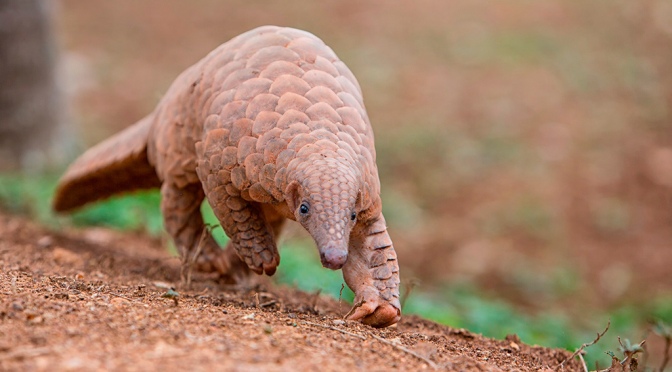The pangolin, of which there are 8 species, is a strange creature that looks like a cross between a reptile and an anteater. In fact, this mammal can climb trees, has a long tongue for finding insects, is covered in keratin scales, can spray foul smelling liquid like a skunk, and are highly endangered (ranging from vulnerable to critically endangered).

The biggest threat to these species is the rate at which they are being hunted and removed from the wild to fuel an illegal trade in their scales, which are believed to have a medical use in some countries. There is no scientific evidence that pangolin scales, which are made from the same substance as rhino horn, and human hair, have any medical uses at all.
The eight species of pangolin can be found across Africa and Asia. On both continents there are plenty of myths and legends surround the creatures and what their scales can be used for. In certain parts of Africa the giant ground pangolin’s scales are thought to bring rain and ward off lions.
What both continents also have in common is that the illegal trade in these creatures is decimating their numbers in the wild. However, there is an international agreement that has just made a decision that could have a massive, positive impact on pangolin conservation.
The Convention on International Trade in Endangered Species of Wild Fauna and Flora (CITES, for short) is an international agreement between government that puts trade regulations on species depending on their status in the wild. This could mean regulating a species so that only 1,000 of a certain primate can be traded per year, or it could put a complete ban on a species.

Depending on how threatened a species is in the wild, it is given one of three Appendices. Appendix I includes species which are threatened with extinction and means that there is extremely limited, if any, trade allowed. Appendix II is for species which may be threatened and require controlled trading that is compatible with their survival. Appendix III is for species that are protected in at least one country and have mildly controlled trade.
Until now, pangolin resided on the Appendix II list which meant some legal trade could continue. However this is a problem when an animal is so frequently smuggled because the numbers of animals being traded could be being lied about, paperwork can be forged, and so on.

At this year’s CITES meeting it was decided that all Asiatic pangolin species, of which there are four, are on a zero annual export. For years, Asian countries have had trouble controlling their illegal trade on pangolins. In fact, on April 13, 2013 roughly 2000 frozen pangolins were found on a Chinese fishing vessel that had run aground.
This new status for the pangolin in the CITES agreement could mean that it will make it much harder for the illegal trade to continue, though it will not solve any problems overnight, it should at least cut down on the numbers of pangolins making it into markets. And when the buying stops, the selling can too.


